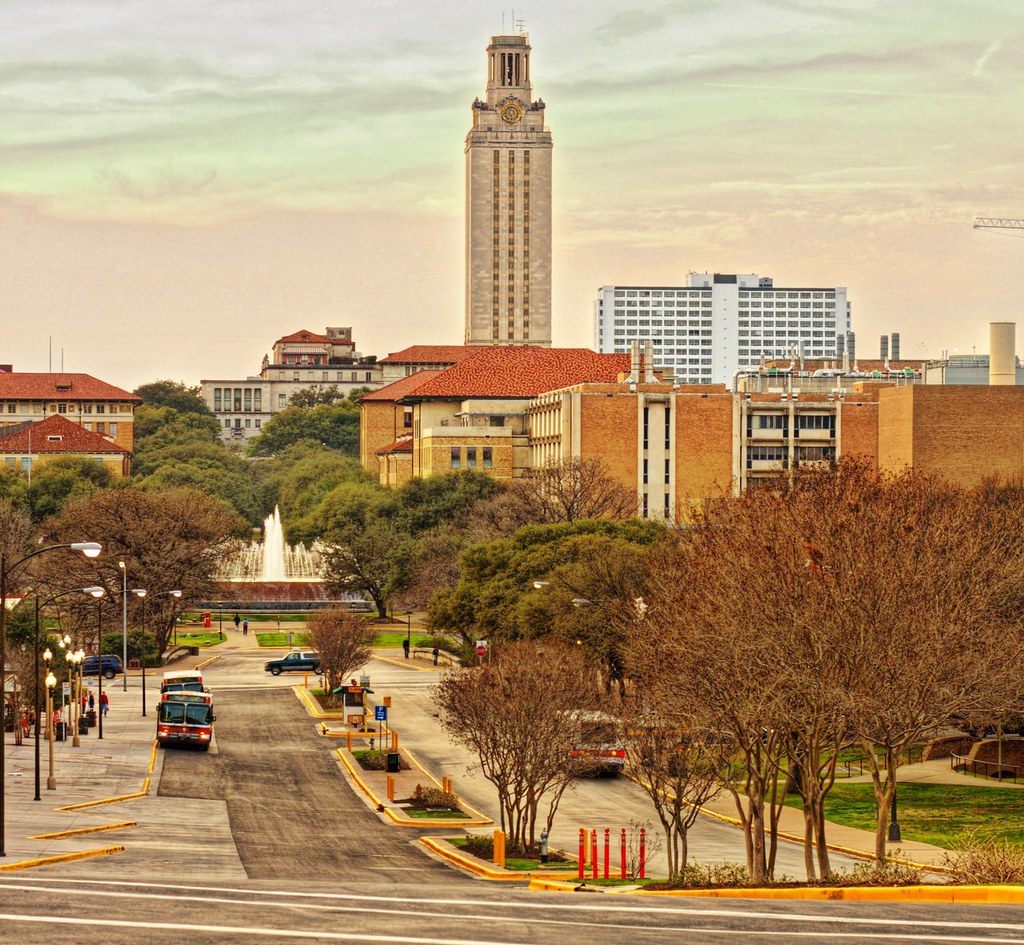
Baylor University Acceptance Rate – Introduction
Located in Waco, Texas, Baylor University is one of the top-ranked universities in Texas. The school was founded in 1845 and is one of the oldest colleges in Texas. It comes in at #77 on the Best Colleges list according to US News. According to US News, the Baylor acceptance rate is 57%.
A historically Baptist university, BU’s students are dedicated to community service, with most students taking part in different volunteer opportunities across campus and in the community. As one of the best colleges in Texas, Baylor is considered a large university, with enrollment hovering around 15,000 undergraduate students.
In this article, we’ll discuss:
- The Baylor acceptance rate
- What “acceptance rates” mean
- How the acceptance rate for Baylor compares to other top Texas colleges
- And more!
Now, let’s take a deeper look at the Baylor acceptance rate and how to get into Baylor.
What is the Baylor acceptance rate?
The Baylor University acceptance rate is 57%.
The acceptance rate for Baylor would be considered selective. Additionally, the Baylor acceptance rate is on par with those of universities such as University of California- San Diego and Southern Methodist University in Dallas.
According to US News, the average college acceptance rates hover around 68%. Given the Baylor acceptance rate of 57%, it is safe to assume that Baylor is more competitive than your average American university. So, as you build your college list, keep in mind that the Baylor acceptance rate is selective across the country, college acceptance rates are actually increasing.
The acceptance rate for Baylor also aligns with those of other large, private universities across the country. These schools include University of Tampa, Fordham University, and Syracuse University. The Baylor University acceptance rate is also on par with other universities with similar demographics.
Click here to learn more about the admissions process for Baylor.
Breaking down the Baylor acceptance rate
Like any acceptance rate, the Baylor University acceptance rate is based on the number of students that get in vs. the number of students that apply. It is important to note that while a college acceptance rate is an important consideration when building your college list, it isn’t everything. College acceptance rates do not account for factors such as location, cost, or quality of education. This can vary widely from university to university and can greatly impact a student’s college list. So, while you should consider college acceptance rates, you should not use it as your only tool in choosing colleges.
When it comes to the Baylor acceptance rate, you should also consider the average SAT and ACT scores. These can help you decide where Baylor should fall on your college list. There are no official Baylor SAT requirements. However, the middle 50% of SAT scores are between 1170–1360, and the middle 50% of ACT scores are 26–32. There are no official Baylor GPA requirements either. However, the average Baylor GPA is around a 3.7. Remember that SAT scores play a role in the Baylor acceptance rate—the higher your score, the higher your admissions odds. So, be sure that your SAT score falls as close as possible to the 1170-1360 range.
That being said, keep in mind that Baylor is test-optional through the entering class of Fall 2025. If you think your test scores will enhance your application, then you should submit them. Academics are important to Baylor admissions, however, they do have a holistic review process.
Given the low acceptance rate for Baylor, you should try to remain as close to the average GPA and SAT range as possible. This will help enhance your Baylor application, especially when paired with an excellent resume and strong essays.
Is Baylor hard to get into?

Analyzing college acceptance rates is a great way to assess the difficulty of getting into a college or university. The Baylor acceptance rate tells us that Baylor will be a challenge to get into, though it is not impossible. With one of the top research programs in the country, Baylor is definitely one of the best colleges in Texas.
If you’re vying for Baylor enrollment, note that the admissions process is selective. Since Baylor admits less than half of its annual applications, students should consider Baylor a target or reach school depending on their profile. While there are no official Baylor GPA requirements, you should strive for a high GPA to increase your admissions odds. However, grades aren’t everything. Robust extracurriculars and volunteer work will also bolster your Baylor application.
Remember that the Baylor University acceptance rate doesn’t reflect whether it’s “hard” or “easy” to get into the school. Instead, it just gives us a rough estimate of how many students are admitted per year. The Baylor acceptance rate provides a frame of reference, but it only gives us one piece of the application process puzzle.
What is a good acceptance rate?
Overall, there’s no such thing as a “good” or “bad” college acceptance rate. Low acceptance rates are often associated with a school’s prestige. By contrast, higher acceptance rates give you a better chance of getting in, and you can get an excellent education at a wide variety of colleges.
Keep in mind that the acceptance rate for Baylor—and every other college and university—is the ratio of how many students apply to a college vs. how many are accepted. For example, the Baylor University acceptance rate is 57%, and in Fall 2022 there were 3,296 students in the incoming freshman class. This makes the Baylor acceptance rate high but attainable. However, you should also keep in mind that Baylor is a larger school. This means more students apply, but more students are accepted.
Still, remember that there is so much more to a college than just its acceptance rate. On the same token, there isn’t necessarily a “bad” acceptance rate. Choosing a college is about finding the right fit for you—regardless of the acceptance rate. For instance, a student might get accepted to a school with an acceptance rate that is lower than the Baylor acceptance rate. However, if that school doesn’t have the student’s desired major, then it isn’t the right fit. Read on to learn more about these trends among the best colleges in Texas.
Baylor acceptance rate vs. other Top Colleges in Texas

We’ve discussed the Baylor admissions process and learned about the Baylor acceptance rate. Now, let’s compare the Baylor University acceptance rate to other schools in Texas.
University of Texas at Austin has an acceptance rate of 29%. UT Austin falls below the Baylor acceptance rate of 57%, placing it in the “most selective” category.
Comparatively, Rice University, located in Houston, has an acceptance rate of just 9%. While the Baylor acceptance rate is significantly higher, keep in mind that Rice University has a total enrollment of 4,000 students, while Baylor has 15,000.
For those looking to attend school in Texas, students may consider applying to a safety school such as University of Texas – Dallas, with an admissions rate of 87%. This is significantly higher than the Baylor acceptance rate, making it an excellent option for a safety school.
The Baylor acceptance rate hovers at just over 50%. However, while the acceptance rate for Baylor is higher than that of Rice, Baylor is still one of the top colleges in the state. In fact, when compared to other top colleges and universities in Texas, Baylor is #5 according to US News college rankings.
When looking at the Baylor University acceptance rate, it is important to understand how different Baylor is from Rice, UT Austin, and UT Dallas. All four schools are top schools in Texas, but their programs, sizes, and offerings vary widely. So, remember that the Baylor acceptance rate is just one factor in your college search.
Baylor acceptance rate Trends: What you should know
Today, Baylor enrollment is over 20,000 students, and the acceptance rate for Baylor is 57%.
However, the Baylor acceptance rate has seen a shift over the last few years. Since 2021, the Baylor acceptance rate has gone down, dropping by 10%. In fall 2022, Baylor saw a large increase in applicants, with nearly 51,000 applications. This year’s freshman class was also smaller than the past two years’ freshman classes. Due to the increase in Baylor applications, the acceptance rate for Baylor will likely decline over time.
The Baylor GPA requirements have not changed over the past few years. However, as the school becomes increasingly selective, the average GPA for admitted students might go up as well. Similarly, while there are no Baylor SAT requirements, you can expect the average SAT score among admitted students to remain high.
Baylor acceptance rate and your college list
The middling Baylor acceptance rate makes Baylor an excellent school to consider. However, when creating a college list, you should break down schools into three categories: reach, target, and safety schools.
College Acceptance Rate Breakdowns
College lists should typically have about 10-14 schools on them. How can college acceptance rates play a role?
- 2-4 safety schools, with a 75% college acceptance rate or higher
- 4-6 target schools, with a 25- 75% college acceptance rate
- 3-4 reach colleges, with a 25% college acceptance rate or lower
For most students, the Baylor University acceptance rate would indicate that Baylor is considered a target school. By building a balanced list, you can apply to selective colleges while still ensuring you have options among your target and safety schools. You can use the acceptance rate for Baylor as an indicator when creating your college list: if you have a 57% chance of getting in, you want to make sure that you have schools that will have higher acceptance rates. You can also opt to apply to schools with lower ones to make sure you have enough options.
Other Baylor Admissions statistics to consider

We’ve looked at the Baylor acceptance rate and how it compares to those of other schools. Next, let’s take a closer look at what Baylor has to offer before we dig into other admissions statistics.
Baylor University boasts over 125 different majors and minors. Top majors include Nursing/Registered Nursing, Biology, Accounting, Health/Medical Preparatory Programs, Marketing/Marketing Management and Finance. Baylor also has an Honors College that has its own dorms exclusive to students in the program.
Baylor also hosts a number of clubs and campus organizations, including excellent athletics programs. The Baylor Bears basketball team competes within the major NCAA conference known as the “Big 12”. Baylor also has a robust Greek Life and is home to more than 40 sororities and fraternities. With so much to offer, the selective Baylor University acceptance rate is only one of many reasons to apply.
Career prospects also look good for Baylor grads: notable alumni include Angela Kinsey from The Office, Britney Griner of the WNBA, and television personalities Chip and Joanna Gaines. According to the US News, alumni can expect their starting salaries to average $53,400.
Next, let’s look a bit more at Baylor admissions, using the Baylor acceptance rate for context.
The vast majority of students scored 1200+ on the SAT. Additionally, nearly 43% of students come from out of state. As a private school, Baylor admissions may be appealing to a wider range of students—not just those living in Texas. With the Baylor acceptance rate of 57% and its strong academic programs, the school has plenty to offer students interested in traveling out of their home state.
Baylor is also home to a relatively diverse student body. In the 2022 admissions cycle 35.4% of enrolled students identified as underrepresented minorities.
However, as you consider the Baylor acceptance rate and other admissions statistics, you should think about other factors. For instance, the Baylor online course catalog has grown in recent years. When considering colleges and universities, do keep an eye out for online course offerings. This can help you get ahead in academics during summer and winter semesters while off campus.
Baylor acceptance rate – Final Thoughts
The acceptance rate for Baylor is relatively selective. Additionally, there is a level of prestige that comes with the Baylor University acceptance rate. With the average college acceptance rate being 68% and the Baylor acceptance rate being 57%, it goes without saying that Baylor is relatively competitive.
However, keep in mind that there is more to the “perfect fit.” When applying to colleges, be sure to consider the Baylor acceptance rate as you build your college list. However, don’t discount other things that may be important to you. Baylor is also an excellent school for those looking to explore a wide variety of majors and join different organizations.
When building your college list, be sure to consider all of the aspects that make a college unique. Think about location, demographics, majors offered, opportunities for study abroad, and externships, among other factors. Every college will have different programs—and acceptance rates. It is important to look at a college as a house; the college acceptance rate is just one of the rooms.
Remember: the Baylor University acceptance rate shouldn’t be the only reason you apply. However, the Baylor University acceptance rate can help guide you in building out your college list. It can also provide you with perspective as to where Baylor holds up in relation to other colleges and universities.
Now that you have learned more about the Baylor University acceptance rate, you can learn about how to get into Baylor using our guide here. There, you’ll find even more information on the Baylor University acceptance rate, admissions statistics, application process, and more.

This guide to Baylor University Acceptance Rate was written by senior advisor, Shari Farberman. Looking for more admissions support? Click here to schedule a free meeting with one of our Admissions Specialists. During your meeting, our team will discuss your profile and help you find targeted ways to increase your admissions odds at top schools. We’ll also answer any questions and discuss how CollegeAdvisor.com can support you in the college application process.
